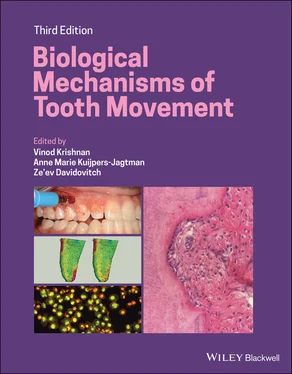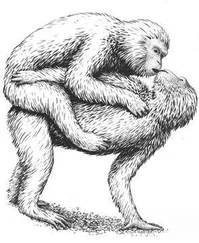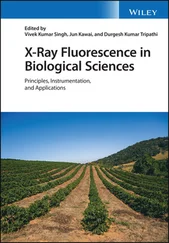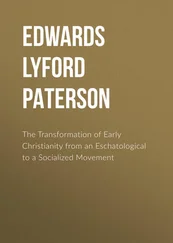Margarita Zeichner‐David, PhDClinical Professor, Division of Biomedical Sciences, Herman Ostrow School of Dentistry of USC, Los Angeles, CA, USA
Preface to the First Edition
The first international conference on the biology of tooth movement was held in November 1986 at the University of Connecticut, under the leadership of Louis A. Norton and Charles J. Burstone. In the Foreword to the book that emanated from that conference, Coenraad F.A. Moorrees, to whom the first edition of this book is dedicated, wrote:
Notwithstanding continued progress from numerous histologic and biochemical studies describing tissue behavior after force application, the key question on the biology of tooth movement remains unresolved: namely, how force application evokes molecular response in the cells of the periodontal membrane. Only when this fundamental question in bone physiology is better understood can appliances for optimal tooth movement in orthodontics be achieved.
In the two decades that have passed since that conclusion, scientists worldwide seem to have followed the direction pointed out by Professor Moorrees. Basic research pertaining to the response of tissues and cells to mechanical loading has grown broader and deeper. The emphasis at the end of the first decade of the twenty‐first century is on molecular biology and molecular genetics. Genes are being identified which seem to play important roles in the response of paradental cells and tissues to orthodontic forces, and a growing number of signal molecules that modulate this process have been elucidated. These findings now enable clinicians to utilize some of these molecules as markers of processes associated with tooth movement, such as inflammation and root resorption.
This unrelenting increase of knowledge in basic science has not yet resulted in the development of orthodontic appliances that can be tailored to fit the biological peculiarities of individual patients. But with the growing understanding of the nature of various common diseases, such as diabetes, asthma, arthritis, obesity, and various cardiovascular diseases, it is now possible to assess their potential effects on orthodontic tooth movement, clinically and molecularly. The time seems to be approaching when the nature of optimal orthodontics will be fully exposed as a consequence of the increasing widening of the highway connecting clinical and basic sciences.
The goal of this book is to inform orthodontic students as well as practitioners on the known details of the biological aspects of tooth movement. We hope that this information will enhance their ability to render excellent treatment to all of their patients, young and old. Moreover, we hope that this compendium will convince readers that the dentofacial complex is an integral part of the complete human body, and as such, and like any other region of the body, is prone to be influenced by many factors, genetic or environmental.
Vinod Krishnan Ze’ev Davidovitch Editors
Preface to the Second Edition
Basic biologic research in orthodontics has witnessed rapid growth since the publication of the first edition of Biological Mechanisms of Tooth Movement . This research not only identified biologic factors associated with tooth movement and its iatrogenic reactions but has expanded even deeper into exploration at the molecular and genomic levels, to generate new knowledge that can be used in clinical settings.
The concept of personalized or individualized medicine is rapidly gaining a hold in medicine as may be seen from the global annual conferences on this subject. In medicine, at this time, the focus is on the personal determinants of cancer and diabetes. Efforts to adapt this concept to all of medicine are gaining momentum. Dentistry is no exception, and orthodontics is potentially the pioneer in this regard. Orthodontists have long been customizing their diagnoses and treatment plans according to the physical characteristics of their patients but now we are entering a period when it would be possible to evaluate the biological features of each patient, by measuring specific tissue markers in fluids, such as saliva and gingival crevicular fluid. The task of establishing reliable tests for the identification of the sought‐for markers may not be imminent because of the complexity and variability of the individual genomics but investigations of this pathway have already begun.
The role of basic biologic research has frequently been portrayed as the identification of factors and processes that participate in clinical functions, and test the validity of any hypothesis regarding the efficacy and safety of new and old clinical methods. The specialty of orthodontics has benefitted from this relentless flow of new information, derived from a plethora of publications in numerous scientific periodicals, which focused on mechanism of mechanotransduction, the birth, life and death of the osteoclast, the molecular genetics of bone modeling and remodeling, and the effects of hormones and drugs on soft and mineralized connective tissues. This ongoing growth in information is already affecting clinical orthodontics. One major concept gaining support is the proven ability of bone and periodontal fibroblastic cells to respond simultaneously to more than one signaling factor. Evidence in support of this principle has already led to the application, in addition to orthodontic force, of surgical procedures, vibrations, laser radiation, electricity, and vitamin D3. All of these factors have displayed an ability to enhance the velocity and reduce the duration of tooth movement. The orthodontist now has at his/her disposal a choice of methods, invasive and noninvasive, local and systemic, that can augment the pace of tissue changes that facilitate tooth movement. These mechanisms act on the tissue and cellular levels, and can be manipulated based on increasing knowledge derived from worldwide laboratory experiments and clinical trials, all of which elevate the clinical potential of orthodontics to attain positive results, with a long‐range stability, and with a low risk for undesirable side effects.
We are pleased to present this second edition of Biological Mechanisms of Tooth Movement , in which we have assembled chapters about topics closely related to the basic biologic aspects of orthodontics , which affect the movement of teeth during orthodontic treatment. It updates most of the subjects addressed in the first edition, and includes new topics, such as the search for efficient methods to accelerate tooth movement.
We would like to thank all our contributors who have demonstrated dedication to this project. We would also like to express our sincere appreciation to the book reviewers, who critically analyzed the first edition of the book and let us know its shortcomings so that the second edition is made much stronger. We express our gratitude to our publisher, Wiley‐Blackwell, especially Sophia Joyce, Hayley Wood, Jessica Evans, Sara Crowley‐Vigneau, and Katrina Hulme‐Cross, who helped us complete the project successfully. We would also like to thank the support staff, Jayavel Radhakrishnan, David Michael and all others, who worked tirelessly to facilitate this publication.
As we have stated in the preface to the first edition of this book, “ we really hope that this compendium will convince the readers that the dentofacial complex is an integral part of the complete human body, and as such, is prone to be influenced by any factor, genetic or environmental, like any other region of the body.” Orthodontic academicians and clinicians increasingly recognize this principle and try to treat patients as humans, not merely as typodonts. We hope that this book will assist all orthodontists in this effort.
Читать дальше












